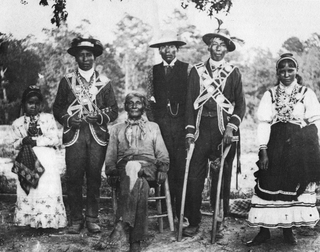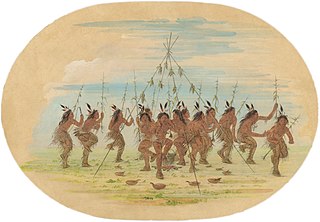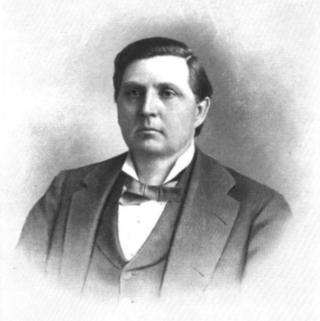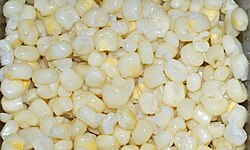
Marshall County is a county located on the south central border of Oklahoma. As of the 2020 census, the population was 15,312. Its county seat is Madill. The county was created at statehood in 1907 from the former Pickens County of the Chickasaw Nation. It was named to honor the maiden name of the mother of George Henshaw, a member of the 1906 Oklahoma Constitutional Convention. The county and its cities are part of the Texoma region.

The Chickasaw are an Indigenous people of the Southeastern Woodlands, United States. Their traditional territory was in northern Mississippi, northwestern and northern Alabama, western Tennessee and southwestern Kentucky. Their language is classified as a member of the Muskogean language family. In the present day, they are organized as the federally recognized Chickasaw Nation.

Choctaw mythology is part of the culture of the Choctaw, a Native American tribe originally occupying a large territory in the present-day Southeastern United States: much of the states of Mississippi, Alabama, and Louisiana. In the 19th century, the Choctaw were known to European Americans as one of the "Five Civilized Tribes" even though controversy surrounds their removal.

The term Five Civilized Tribes was applied by European Americans in the colonial and early federal period in the history of the United States to the five major Native American nations in the Southeast, the Cherokee, Chickasaw, Choctaw, Muscogee, and Seminoles. Americans of European descent classified them as "civilized" because they had adopted attributes of the Anglo-American culture.

Gumbo is a hearty stew popular in the U.S. state of Louisiana, and is the official state cuisine. Gumbo consists primarily of a strongly flavored stock, meat or shellfish, a thickener, and the Creole "holy trinity" ― celery, bell peppers, and onions. Gumbo is often categorized by the type of thickener used, whether okra or filé powder.

A hush puppy is a small, savory, deep-fried round ball made from cornmeal-based batter. Hushpuppies are frequently served as a side dish with seafood and other deep-fried foods.

The stomp dance is performed by various Eastern Woodland tribes and Native American communities in the United States, including the Muscogee, Yuchi, Cherokee, Chickasaw, Choctaw, Delaware, Miami, Caddo, Tuscarora, Ottawa, Quapaw, Peoria, Shawnee, Seminole, Natchez, and Seneca-Cayuga tribes. Stomp dance communities are active in North Carolina, Oklahoma, Alabama, Mississippi, and Florida.

The Green Corn Ceremony (Busk) is an annual ceremony practiced among various Native American peoples associated with the beginning of the yearly corn harvest. Busk is a term given to the ceremony by white traders, the word being a corruption of the Creek word puskita (pusketv) for "a fast". These ceremonies have been documented ethnographically throughout the North American Eastern Woodlands and Southeastern tribes. Historically, it involved a first fruits rite in which the community would sacrifice the first of the green corn to ensure the rest of the crop would be successful. These Green Corn festivals were practiced widely throughout southern North America by many tribes evidenced in the Mississippian people and throughout the Mississippian Ideological Interaction Sphere. Green Corn festivals are still held today by many different Southeastern Woodland tribes. The Green Corn Ceremony typically occurs in late July–August, determined locally by the ripening of the corn crops. The ceremony is marked with dancing, feasting, fasting and religious observations.
Boggy Depot is a ghost town and Oklahoma State Park that was formerly a significant city in the Indian Territory. It grew as a vibrant and thriving town in present-day Atoka County, Oklahoma, United States, and became a major trading center on the Texas Road and the Butterfield Overland Mail route between Missouri and San Francisco. After the Civil War, when the MKT Railroad came through the area, it bypassed Boggy Depot and the town began a steady decline. It was soon replaced by Atoka as the chief city in the area. By the early 20th century, all that remained of the community was a sort of ghost town.

The Chickasaw Nation is a federally recognized Native American tribe with headquarters in Ada, Oklahoma, in the United States. They are an Indigenous people of the Southeastern Woodlands, originally from northern Mississippi, northwestern Alabama, southwestern Kentucky, and western Tennessee. Today, the Chickasaw Nation is the 13th largest tribe in the United States.

Choctaw Country is the Oklahoma Department of Tourism and Recreation's official tourism designation for Southeastern Oklahoma. The name was previously Kiamichi Country until changed in honor of the Choctaw Nation headquartered there. The current definition of Choctaw Country includes ten counties, being Coal, Atoka, Bryan, Choctaw, McCurtain, Pushmataha, Le Flore, Latimer, Haskell, and Pittsburg counties. The department created the term as one of six designated travel regions within the state. However, other definitions of Southeastern Oklahoma may include additional counties.

Sardis Lake is a reservoir in Pushmataha and Latimer counties in Oklahoma, USA. It was created about 1980 as the result of a dam constructed on Jackfork Creek, a tributary of the Kiamichi River, by the United States Corps of Engineers under contract to the state. It is named for the now-defunct town of Sardis, Oklahoma, which had to be abandoned before the area was submerged in the flooding of the lake.. The lake is located approximately 5 miles (8.0 km) north of Clayton. It is part of the Kiamichi Basin.

Douglas Hancock Cooper Johnston, also known as "Douglas Henry Johnston", was a tribal leader who served as the last elected governor of the Chickasaw Nation from 1898 to 1902. He was re-elected in 1904 and, after the Dawes Act changed how tribal lands were allocated and regulated in Indian Territory to allow statehood in 1907, he was appointed by President Theodore Roosevelt in 1906 as governor of the tribe under federal authority. He served until his death in office in 1939.

Bloomfield Academy was a Chickasaw school for girls founded in 1852 by the Reverend John Harpole Carr, located in the Chickasaw Nation in Indian Territory, about 3 miles (4.8 km) southeast of the present town of Achille, Oklahoma. A boarding school funded by both the Missouri Conference of the Methodist Church and the government of the Chickasaw Nation, it operated there until 1914, which a major fire destroyed most buildings. Now privately owned, the site of the former academy near Achille was listed on the National Register of Historic Places in 1972.

An Organic Act is a generic name for a statute used by the United States Congress to describe a territory, in anticipation of being admitted to the Union as a state. Because of Oklahoma's unique history an explanation of the Oklahoma Organic Act needs a historic perspective. In general, the Oklahoma Organic Act may be viewed as one of a series of legislative acts, from the time of Reconstruction, enacted by Congress in preparation for the creation of a united State of Oklahoma. The Organic Act created Oklahoma Territory, and Indian Territory that were Organized incorporated territories of the United States out of the old "unorganized" Indian Territory. The Oklahoma Organic Act was one of several acts whose intent was the assimilation of the tribes in Oklahoma and Indian Territories through the elimination of tribes' communal ownership of property.
Mary Frances Thompson Fisher, best known as Te Ata, was an actress and citizen of the Chickasaw Nation known for telling Native American stories. She performed as a representative of Native Americans at state dinners before President Franklin D. Roosevelt in the 1930s. She was inducted into the Oklahoma Hall of Fame in 1957 and was named Oklahoma's first State Treasure in 1987.
William A. Durant was a politician in the U.S. state of Oklahoma. He served as chief of the Choctaw Nation in Indian Territory, a member and Speaker of the Choctaw Nation and as the third Speaker of the Oklahoma House of Representatives.

Indigenous North American stickball is a team sport typically played on an open field where teams of players with two sticks each attempt to control and shoot a ball at the opposing team's goal. It shares similarities to the game of lacrosse. In Choctaw Stickball, "Opposing teams use handcrafted sticks or kabocca, and a woven leather ball, or towa. Each team tries to advance the ball down the field to the other team's goalpost using only their sticks, never touching or throwing the ball with their hands. Points are scored when a player hits the opposing team's goalpost with the ball."
Chief Carl Terry Saul (1921–1976) also known as C. Terry Saul and Tabaksi, was a Choctaw Nation/Chickasaw illustrator, painter, muralist, commercial artist, and educator. He was a leader of the Choctaw/Chickasaw tribe. He served as Director of the art program at Bacone College in Muskogee, Oklahoma, from 1970 until 1976.














